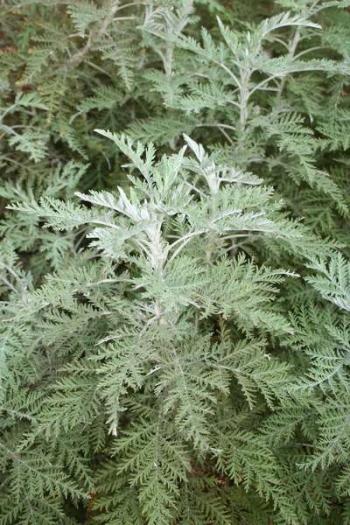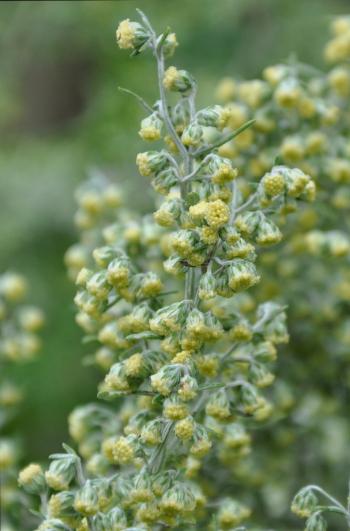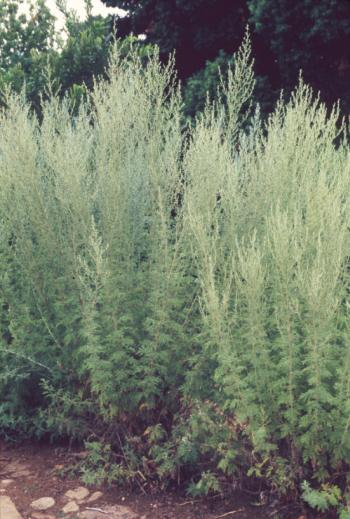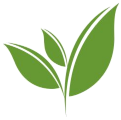About Artemisia afra
Artemisia afra Jacq. ex Willd.
Source: http://pza.sanbi.org/artemisia-afra
Family: Asteraceae
Common names: wild wormwood, African wormwood (Eng.); wilde-als (Afr.); umhlonyane (isiXhosa); mhlonyane (isiZulu); lengana (Tswana); zengana (Southern Sotho)
Named after the Greek goddess Artemis, this soft aromatic shrub is one of the most popular medicinal plants in South Africa. Easy to grow, Artemisia afra is an essential part of the herb garden, and with its silver-grey foliage it makes a striking display in any garden.

Artemisia afra, attractive silvery fern-like foliage”
Description
Artemisia afra grows in thick, bushy, slightly untidy clumps, usually with tall stems up to 2 m high, but sometimes as low as 0.6 m. The stems are thick and woody at the base, becoming thinner and softer towards the top. Many smaller side branches shoot from the main stems. The stems are ribbed with strong swollen lines that run all the way up. The soft leaves are finely divided, almost fern-like. The upper surface of the leaves is dark green whereas the undersides and the stems are covered with small white hairs, which give the shrub the characteristic overall grey colour. Very typical of A. afra is the strong, sticky sweet smell that it exudes when touched or cut.
Artemisia afra flowers in late summer, from March to May. The individual creamy yellow flowers are small (3-4 mm in diameter), nodding and crowded at the tips of the branches.
Conservation Status
Artemisia afra is not threatened, and is assessed as Least Concern (LC) on the Red List of South African plants.
Distribution and habitat
Artemisia afra is a common species in South Africa with a wide distribution from the Cederberg Mountains in the Cape, northwards to tropical East Africa and stretching as far north as Ethiopia. In the wild it grows at altitudes between 20-2 440 m on damp slopes, along streamsides and forest margins.
A. afra is the only indigenous species in this genus. A. vulgaris is naturalized in the Eastern Cape. It is an annual, indigenous to Europe, Iran, Siberia and North Africa, is commonly known as mugwort, and is described by Huxley et al. (1992) as ‘a condiment with supposed magical properties’.


World-wide there are about 400 species of Artemisia, mainly from the northern hemisphere. Many of the other Artemisia species are aromatic perennials and are used medicinally. Lesley Bremness (1988) in The complete book of herbs, mentions that wormwood is included for its internal worm-expelling properties in the ancient Greek text of Dioscorides; Indians from New Mexico use similar varieties to treat bronchitis and colds; and the Chinese still use wormwood rolled up in the nostril to stop nosebleeds.
Derivation of name and historical aspects
The genus name Artemisia honours Artemis, the Greek goddess of hunting (Jackson 1990). Another interesting link to the name is Artemisia, the wife of the Greek/Persian King Mausolus, who ruled after his death in 353 BC. In his honour she built a magnificent tomb called the Mausoleum, known as one of the Seven Wonders of the Ancient World. She was also a famous botanical and medical researcher (Bremness 1988). The species name afra means from Africa.
Uses
Artemisia afra is one of the oldest and best known medicinal plants, and is still used effectively today in South Africa by people of all cultures. The list of uses covers a wide range of ailments from coughs, colds, fever, loss of appetite, colic, headache, earache, intestinal worms to malaria. Artemisia is used in many different ways and one of the most common practices is to insert fresh leaves into the nostrils to clear blocked nasal passages (Van Wyk et al. 1997). Another maybe not so common use is to place leaves in socks for sweaty feet (Watt & Breyer-Brandwijk 1962). The roots, stems and leaves are used in many different ways and taken as enemas, poultices, infusions, body washes, lotions, smoked, snuffed or drunk as a tea. A. afra has a very bitter taste and is usually sweetened with sugar or honey when drunk. Wilde-als brandy is a very popular medicine still made and sold today. Margaret Roberts (1990) lists many other interesting uses in her book, Indigenous healing plants, which includes the use of A. afra in natural insecticidal sprays and as a moth repellent. She also mentions that wilde-als with its painkilling and relaxing properties could be of real value to today’s stressful society.
Growing Artemisia afra
Artemisia afra has traditionally been part of the herb garden, but this indigenous species is just as attractive in the garden used for display. Many of the exotic artemisias are popular garden plants. This tough and easy-to-grow species adds texture and colour with its fine, silver-grey foliage. At Kirstenbosch it is often used in herbaceous plantings mixed with other summer and autumn perennials like the wild sages Hemizygia obermeyerae, Orthosiphon labiatus, Leonotis leonurus and Syncolostemon densiflorus, which make very interesting combinations of foliage and flower colour throughout the summer.
Artemisia afra needs full sun and heavy pruning in winter to encourage new lush growth in spring. Actively growing in the summer months, it should be able to take quite low temperatures during the winter months. Fast-growing, established shrubs are very tough and will slowly spread to form thicker clumps. New plants can be propagated by division or from cuttings that root easily in spring and summer. Seed can be sown in spring or summer.
References
- Bremness, L. 1988. The complete book of herbs. Dorling Kindersley, London.
- Germishuizen, G. & Meyer, N.L. 2003. Plants of southern Africa: an annotated checklist. Strelitzia 14. National Botanical Institute, Pretoria.
- Goldblatt, P. & Manning, J. 2000. Cape plants. A conspectus of the Cape flora of South Africa. Strelitzia 9. National Botanical Institute, Cape Town.
- Hutchings, A. 1996. Zulu medicinal plants. University of Natal Press, Pietermaritzburg.
- Huxley, A., Griffiths, M. & Levy, M. (eds). 1992. The new Royal Horticultural Society dictionary of gardening. Macmillan Press, London.
- Jackson, W.P.U. 1990. Origins and meanings of names of South African plant genera. University of Cape Town.
- Leistner, O.A. (ed.). 2000. Seed plants of southern Africa: families and genera. Strelitzia 10. National Botanical Institute, Pretoria.
- Pooley, E. 2003. Mountain flowers. The Flora Publications Trust, Durban.
- Roberts, M. 1990. Indigenous healing plants. Southern Book Publishers, Halfway House, South Africa.
- Van Wyk, B., Van Oudtshoorn, B. & Gericke, N. 1997. Medicinal plants of South Africa. Briza Publications, Pretoria.
- Watt, J. & Breyer-Brandwijk, M.G. 1962. Medicinal and poisonous plants of southern and eastern Africa. Livingstone, London.
Liesl van der Walt
Kirstenbosch National Botanical Garden
April 2004
